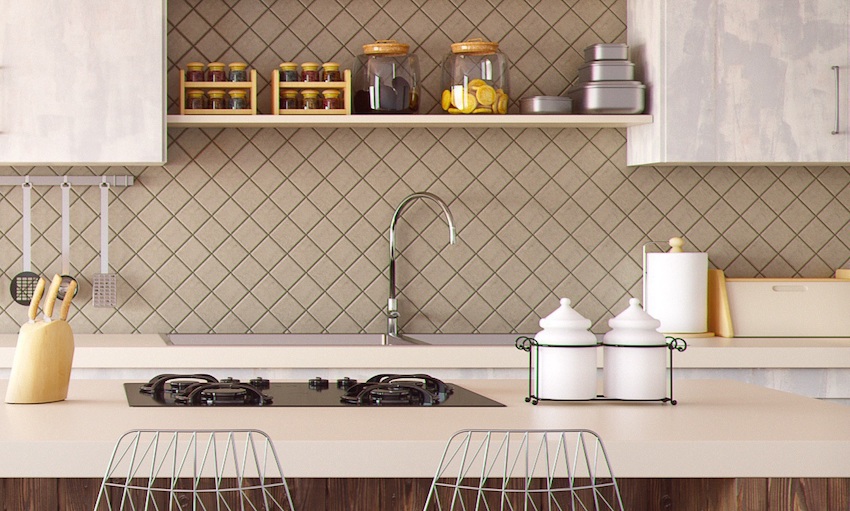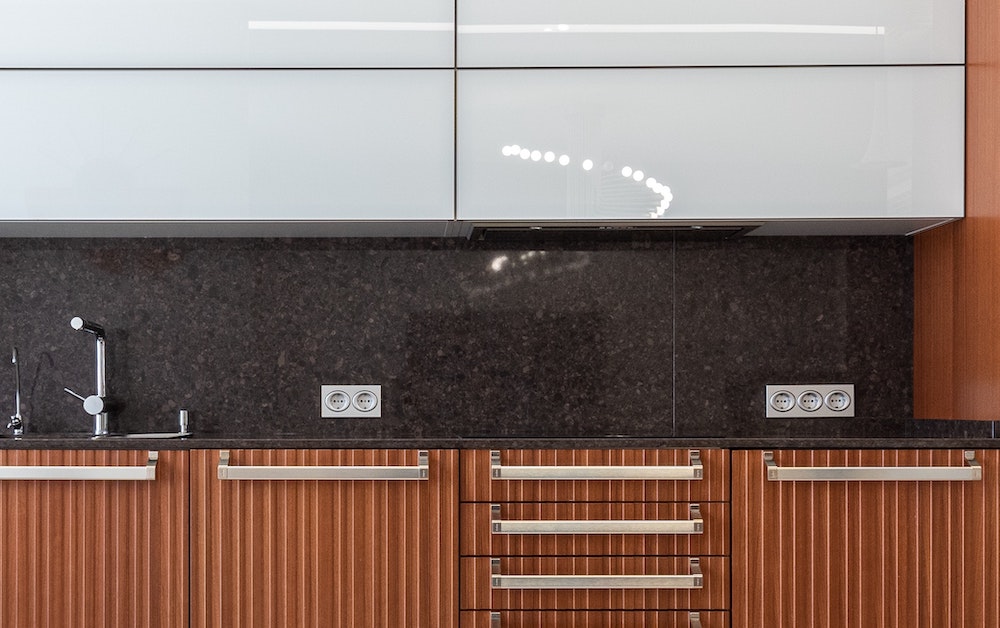What Are Splashbacks in Kitchens?

Splashbacks are an essential, yet often overlooked, feature of our kitchens.
Not only do they protect our walls from spills, splatters, and splashes, but they also add an aesthetic touch to the overall design.
In this post, we will look into what kitchen splashbacks are, the different types available, and why they're a crucial component in any kitchen setup.
Let's explore more about these practical and stylish additions that can truly transform your kitchen.
Click here to see our range of aluminium splashbacks from Alusplash.
What Is A Splashback?
A splashback is a panel installed on the wall behind a kitchen's cooker, sink, or countertop.
Its primary purpose is to protect the walls from splashes, stains, and possible damage caused by cooking or food preparation activities.
While it serves a functional role, a splashback also contributes significantly to the aesthetics of a kitchen, offering an opportunity for visual flair.
They can be made from various materials, including glass, stainless steel, tiles, or stone, each providing a unique look and varying levels of durability and ease of cleaning.
Whether you're aiming for a sleek, contemporary look or a more traditional kitchen style, the splashback can play a key part in achieving your desired aesthetic.
Related Post: How To Cut An Acrylic SplashbackWhat Are the Benefits of Kitchen Splashbacks?
They offer several benefits that make them a popular choice in both traditional and contemporary kitchen designs.
Here are some key advantages:
- Protection: The primary purpose of a kitchen splashback is to protect your walls from spills, splatters, and stains. This is particularly important around the hob and sink where splashes are most common.
- Easy to Clean: Most splashbacks are designed to be easy to clean. Materials like glass, stainless steel, and tiles are resistant to stains and can be wiped clean with a damp cloth and some mild detergent.
- Heat Resistance: Splashbacks, especially those made from glass or stainless steel, are usually heat resistant. This makes them ideal for installation behind a cooker or hob, protecting the wall from heat damage.
- Aesthetic Appeal: Besides their practical benefits, splashbacks can also add a touch of style and sophistication to your kitchen. They come in a variety of colours, designs, and materials to suit any kitchen décor.
- Enhances Lighting: Certain types of splashbacks, particularly those with glossy surfaces, can reflect light and help make a kitchen look brighter.
- Easy to Install and Replace: Kitchen splashbacks are relatively easy to install, and if you fancy a change or need to replace them due to damage, the process is typically straightforward.
- Increases Property Value: A well-designed kitchen with a stylish splashback can increase the overall value of your home, making it an excellent investment for homeowners.
- Hygiene: Because they are easy to clean and provide a seamless surface without grout lines, splashbacks also offer a hygienic solution for your kitchen walls, reducing the risk of mould and bacteria growth.
Related Post: How To Fit A Splashback Over Tiles

Splashbacks vs Tiles Which is Better?
Deciding whether a splashback or tiles are better for your kitchen largely depends on your personal preferences, budget, the style of your kitchen, and your willingness to maintain it.
Both options have their advantages and potential drawbacks.
Kitchen Splashbacks
Kitchen splashbacks are typically made of one solid piece of material such as glass, stainless steel, or acrylic, and provide a sleek and modern look to your kitchen.
They are particularly popular in contemporary designs.
Advantages of Splashbacks:
- Easy to Clean: Splashbacks provide a seamless surface that is easy to clean, and there are no grout lines where dirt and mould can accumulate.
- Modern Appearance: A single sheet of material can give your kitchen a sleek and modern appearance.
- Customisation: You can have splashbacks cut to any size, and they come in various colours and finishes. Some materials, like glass, can even be printed with a personalised design or image.
Drawbacks of Splashbacks:
- Cost: Depending on the material, splashbacks can be more expensive than tiles, especially if you choose a high-end material like back-painted glass.
- Installation: While splashbacks can be DIY installed, it's usually better to have a professional do it, especially for larger or more complex shapes.
Kitchen Tiles
Tiles are traditional, versatile, and come in a wide variety of styles, colours, and materials, from ceramic and porcelain to stone and glass.
Tiles can fit any kitchen style, from rustic to modern.
Advantages of Tiles:
- Variety of Styles: Tiles come in various sizes, shapes, colours, and materials, providing a wide range of design options.
- Heat Resistant: Tiles are typically heat-resistant, making them suitable for areas like behind the stove.
- Cost-Effective: Depending on the type of tile you choose, this can be a cost-effective option.
Drawbacks of Tiles:
- Maintenance: Tiles require grouting, which can discolour over time and may require regular cleaning or even replacement.
- Complex Installation: Tiling requires a certain level of skill and can be time-consuming, especially if you're aiming for complex patterns.
In conclusion, whether a splashback or tiles are 'better' will depend on your kitchen style, the amount of maintenance you're willing to do, your budget, and personal preference.
Both can be excellent choices that add both functionality and aesthetic appeal to your kitchen.
Is a Splashback Essential in a Kitchen?
While a splashback isn't strictly essential in a kitchen from a functional point of view, it is highly recommended for several reasons.
Firstly, they help to protect your kitchen walls from splashes, spills, and stains, especially in areas where cooking is done or water is used, such as behind the hob or the sink.
Without a splashback, these splashes can stain or damage your walls, which can be difficult and expensive to repair.
Secondly, a splashback is much easier to clean than a painted or wall-papered wall.
This makes your kitchen more hygienic, as it's straightforward to wipe down to remove any food splatters or water spots.
Thirdly, a splashback can contribute significantly to the overall look and design of your kitchen.
It can be a focal point and an opportunity to inject colour, texture, and personal style into the space.
Whether you opt for a traditional tiled design, a sleek glass option, or an ultra-modern stainless steel one, it can significantly enhance your kitchen's aesthetic.
Therefore, while you could technically have a kitchen without a splashback, most people find that the benefits of having one far outweigh the costs, both in terms of practicality and design.
What Are the Best Materials for Kitchen Splashbacks?
Kitchen splashbacks can be made from a variety of materials, each with its own advantages and characteristics.
Here are some of the most popular materials used:
- Glass: This is a popular choice for modern kitchens due to its sleek, minimalistic appearance. Glass splashbacks are easy to clean, heat resistant and can be made in virtually any colour. They can also be printed with patterns or images to create a unique design feature.
- Tiles: Tiles are a traditional choice for splashbacks and come in a vast array of colours, sizes, shapes, and patterns, making them incredibly versatile. They are durable and relatively easy to clean, though the grout can discolour over time.
- Stainless Steel: Often seen in professional kitchens, stainless steel is incredibly durable, heat resistant and easy to clean. It gives a modern, industrial feel to a kitchen but can show up smudges and fingerprints quite easily.
- Stone: Materials like granite, marble, or quartz create a luxurious, high-end look. These natural materials are durable and heat-resistant, but can be expensive and may require sealing to prevent stains.
- Acrylic: Acrylic splashbacks can mimic the look of glass at a lower cost. They are also easy to clean and can come in a range of colours, but aren't as heat resistant as some other materials, so may not be suitable for use behind hobs.
- Composite: Composite materials are a mix of two or more materials (such as quartz and resin), combining their strengths. Composites can be very durable, easy to maintain and are available in a range of colours and finishes.
When choosing the best material for your kitchen splashback, consider not only the style of your kitchen but also practical aspects such as heat resistance, ease of cleaning, and your budget.
Some Notes From a Professional Kitchen Fitter and Manufacturer
Years ago, before splashbacks were invented, we only had the option of using ceramic tiles to protect kitchen walls.
But now that splashbacks do existing. In most kitchens I think they are the better option.
They are cheaper to buy and install, they are much easier to clean and, in my opinion - having manufactured, sold and installed thousands of them – I think they look great.
Final Notes on Splashbacks for Kitchens
A kitchen splashback is essentially a protective panel that shields your walls from splatters and stains during cooking or food preparation.
They serve as a crucial element in a kitchen, offering both protection for your walls and a touch of style.
Not only does a splashback offer a practical solution for maintaining a clean and hygienic kitchen, but it also enhances the aesthetics of your space.
While a splashback isn't strictly necessary, it's highly recommended due to its protective features, ease of cleaning, and potential to uplift your kitchen's design.
Choosing the best material for your kitchen splashback is contingent on your kitchen's style, your budget, and practical considerations.
Whether you go for the sleek appearance of glass, the traditional charm of tiles, or the durable nature of composites, your splashback is sure to enhance the functionality and style of your kitchen.


